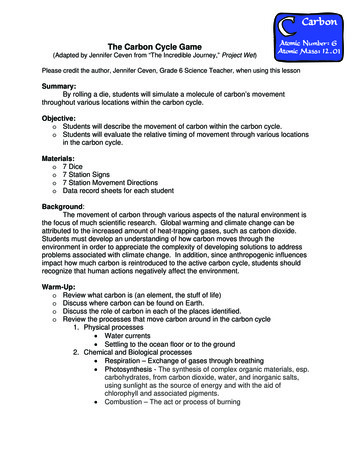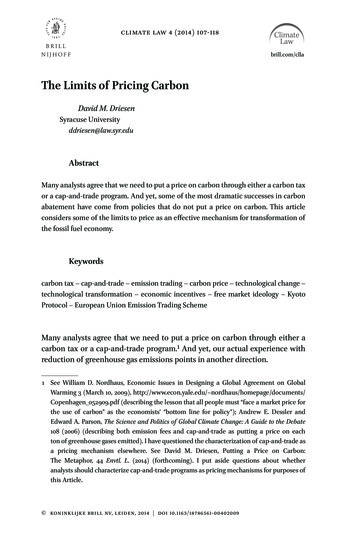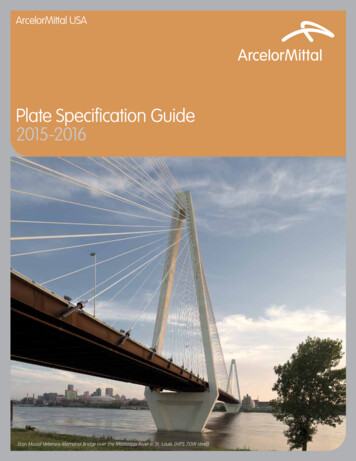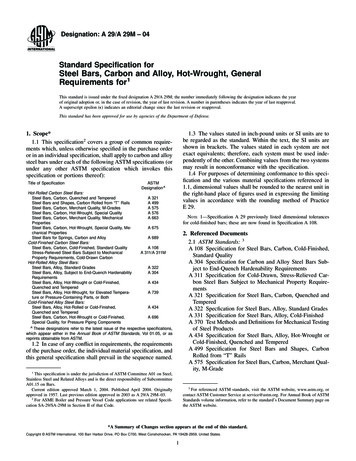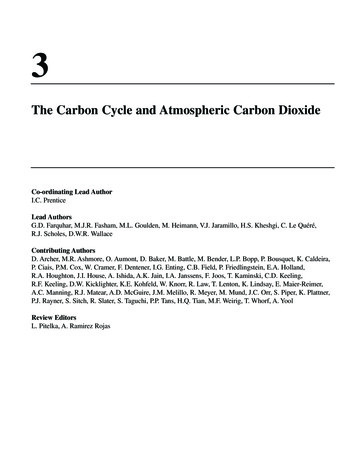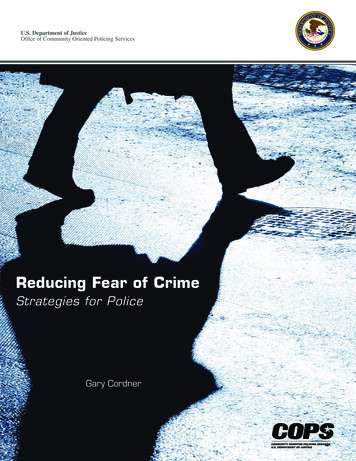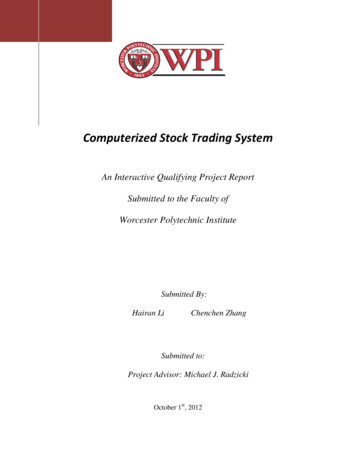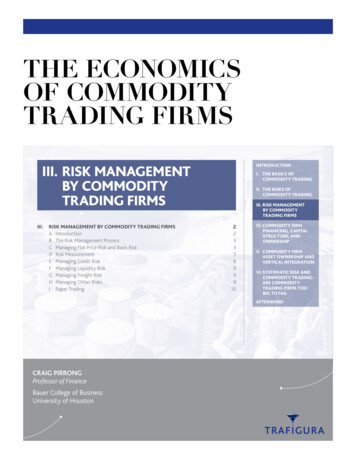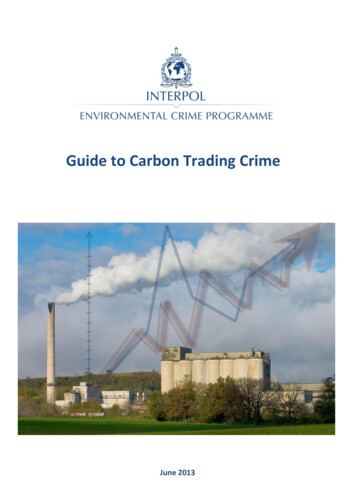
Transcription
Guide to Carbon Trading CrimeJune 2013
AcknowledgementsMembers of the Environmental Crime Committee’s Pollution Crime Working GroupEnvironment CanadaMichigan State UniversityNorwegian Agency for Development CooperationThe Netherlands GovernmentUS Environmental Protection AgencyCarbon-PoliticsCopyright 2013, International Criminal Police Organisation (INTERPOL)Front page photograph: adapted from photograph of US Environmental Protection AgencyDISCLAIMERSThis report has not been formally edited.This publication may be reproduced in whole or in part and in any form for educational or non-profit purposes without special permission fromthe copyright holder, provided acknowledgement of the source is made. INTERPOL would appreciate receiving a copy of any publication thatuses this publication as a source.The content of this publication does not necessarily reflect the views or policies of INTERPOL, its Member countries, or contributoryorganizations, nor does it imply any endorsement. The boundaries and names shown and the designations used on maps do not imply officialendorsement or acceptance by INTERPOL. The designations employed and the presentation of the material in this publication do not imply theexpression of any opinion whatsoever on the part of INTERPOL concerning the legal status of any country, territory, city or area or of itsauthorities, or concerning the delimitation of its frontiers or boundaries.
TABLE OF CONTENTS1INTRODUCTION . - 1 -2OVERVIEW OF CARBON TRADING . - 2 2.1 Calculating the number of carbon credits generated from an emissions reductionproject . - 4 -3CARBON TRADING IN PRACTICE . - 5 3.13.23.33.43.53.63.73.84The European Union . - 7 Australia . - 8 New Zealand . - 8 Tokyo, Japan . - 8 United States . - 8 Canada . - 9 Other markets . - 10 The voluntary carbon market . - 10 -CARBON TRADING’S VULNERABILITY TO CRIMINAL ACTIVITY . - 11 4.1 Manipulating measurements to fraudulently claim additional carbon credits . - 11 4.1.1Additionality . - 13 4.2 Sale of carbon credits that either do not exist or belong to someone else . - 14 4.3 False or misleading claims with respect to the environmental or financial benefits ofcarbon market investments. - 16 4.4 Exploitation of weak regulations to commit financial crimes . - 17 4.5 Tax Fraud . - 18 4.6 Securities Fraud . - 19 4.7 Transfer mispricing . - 20 4.8 Money laundering . - 20 4.9 Internet crimes and computer hacking to steal carbon credits . - 22 4.10 Phishing/Theft of personal information or identity theft . - 24 -5CONCLUSIONS . - 24 5.1 Key recommendations . - 26 -GLOSSARY. - 27 -
INTERPOL Guide to Carbon Trading Crime1INTRODUCTIONOver recent decades there has been a growing scientific consensus that average global temperatures are rising as aresult of increased concentrations of greenhouse gases in the atmosphere caused by human activities, particularlyindustrialization. In response to this scientific evidence, the global community agreed in 1992 to an internationaltreaty, the United Nations Framework Convention on Climate Change (UNFCCC). The treaty requires countries tocooperatively consider what they could do to limit average global temperature increases and the resulting climatechange and to cope with whatever impacts were, by then, inevitable. As at June 2013, the treaty has been ratified by195 parties.1Greenhouse gasesregulated under KyotoProtocol:Carbon dioxide (CO2)Methane (CH4)Nitrous oxide (N2O)Hydrofluorocarbons (HFCs)Perfluorocarbons (PFCs)Sulphur hexafluoride (SF6)1 carbon credit 1 tonne of Carbon Dioxide,or an amount of anothergas with the equivalentglobal warming potential.In 1997, the Kyoto Protocol was adopted as an international agreement underthe UNFCCC and entered into force in February 2005.2 As at June 2013, there are192 parties to the Protocol.3 The major feature of the Protocol is that it setsbinding targets for 37 industrialized countries (the “Annex I” parties)4 and theEuropean Community to reduce their emissions of six specified types ofgreenhouse gases – the three most important being carbon dioxide (CO2),methane (CH4) and nitrous oxide (N2O). The others being hydrofluorocarbons(HFCs), perfluorocarbons (PFCs), and sulphur hexafluoride (SF6). While countriesare encouraged to reduce emissions of all these greenhouse gases, for thepurposes of standardising the measurements, the emissions of these other gasesare converted into the equivalent “global warming potential” of CO2. Forexample, methane (CH4) has 21 times the global warming potential of carbondioxide (which is measured over a 100 year timescale).5 Therefore the emissionof 1 tonne of methane is considered to be equivalent to the emission of 21tonnes of carbon dioxide.While the Kyoto Protocol requires signatory countries to meet their targetsprimarily through domestic measures, it also provides for a number of flexiblemechanisms that allows them to offset their emissions by purchasing reductionsmade in other countries. This is done by purchasing “units”, each unit beingequivalent to one tonne of CO2 (emissions of other greenhouse gases beingconverted to the equivalent number of tonnes of CO2). Through the trading of these units to offset emissions ofgreenhouse gases, a new commodity has been created in the form of emission reductions or removals. Since carbondioxide (CO2) is the principal greenhouse gas, this market is widely referred to as the “carbon market”,6 with each ofthe units traded commonly referred to as “carbon credits”.7Under the Kyoto Protocol, countries are to keep precise records of the trades carried out. Transfers and acquisitionsof carbon credits are tracked and recorded through the registry systems under the Protocol. The UN Climate ChangeSecretariat, based in Bonn, Germany, keeps an international transaction log to ensure secure transfer of carboncredits between countries and to verify that transactions are consistent with the rules of the Protocol.1Status of Ratification of the Convention, UNFCCC, http://unfccc.int/essential background/convention/status of ratification/items/2631.phpKyoto Protocol, UNFCCC, http://unfccc.int/kyoto protocol/items/2830.php3Status of Ratification of the Kyoto Protocol, UNFCCC, http://unfccc.int/kyoto protocol/status of ratification/items/2613.php. The UnitedStates of America signed the Protocol on 12 November 1998 but has not ratified it and is therefore not bound by it. It is the only industrializednation that has not ratified the treaty.4The countries with targets set under the Kyoto Protocol are the industrialized countries, including countries in the former U.S.S.R. Thesecountries are set out in Annex I of the UNFCCC and are commonly referred to as “Annex I Parties”.5See Climate Change 1995, The Science of Climate Change: Summary for Policymakers and Technical Summary of the Working Group I Report,page 22. See http://unfccc.int/ghg data/items/3825.php.6The carbon market is also commonly referred to as a “cap-and-trade regime”. This describes the underlying legal mechanism of the carbonmarket that involves limiting the allowed emissions (the “cap”). Emitters subject to the cap may buy or sell carbon credits to ensure theypossess enough carbon credits to offset their emissions (the “trade”).7Carbon credits are also commonly referred to as “emissions certificates” or “emissions allowances”, as each unit allows a person to emit onemetric tonne of carbon dioxide (CO2) or carbon dioxide equivalent (CO2e).2-1-
INTERPOL Guide to Carbon Trading CrimeEmissions trading schemes may also be established as climate policy instruments at the national and regional levels.Under such schemes, governments set emissions obligations to be reached by the participating entities. TheEuropean Union’s Emissions Trading Scheme (EU-ETS) is the largest in operation.INTERPOL, through its Environmental Crime Programme and the Economic and Financial Crimes sub-Directorate,recognize that emerging carbon markets, like any market, are at risk of exploitation through criminal means andtherefore require proper monitoring and enforcement to ensure environmental and financial integrity. This guide isnot intended to take a position on the value of carbon trading in either a general or specific form but is intended toassess the current vulnerabilities of the existing and emerging carbon markets and provide fundamental informationnecessary to establish adequate policing of these mechanisms. INTERPOL is the only international police organizationwith a trans-boundary mandate, with designated units addressing both environmental and financial crimes. Itsmandate includes the exchange of criminal intelligence and sensitive information between law enforcementagencies amongst INTERPOL’s 190 member countries. INTERPOL recognizes carbon trading crime as a new andemerging type of environmental and financial crime.Before assessing the potential scope for criminal activity, this report offers a comprehensive overview of the carbonmarket and carbon trading in practice, for those unfamiliar with its operations and terminology. Those that have athorough understanding of the process are invited to go straight to the section entitled ‘Carbon Trading’sVulnerability to Criminal Activity’.2OVERVIEW OF CARBON TRADINGThe carbon market is also commonly referred to as a “cap-and-trade” regime. A limit (or “cap) is set for countries orcompanies on the total amount of greenhouse gas emissions they can emit. If they exceed the limit they are requiredto buy carbon credits from others. Those with spare carbon credits may sell surplus credits to emitters that requiremore (the “trade”).Emissions keptbelow capEmissions exceedcapThe Kyoto Protocol has set a “cap” for Countries that have accepted targets for limiting or reducing their emissions.These targets are expressed as a fixed number of Assigned Amount Units (AAUs)8. Each AAU represents an allowanceto emit greenhouse gases equivalent to one tonne of CO2. If the country exceeds its allowed emissions it needs tooffset its (excess) emissions by purchasing reductions made in another jurisdiction.There are a number of different types of units that may be purchased as offsets. Each of these units is given adifferent name depending upon the legal jurisdiction in which it is generated. In each case, however, each unit isstandardised to one carbon credit, the equivalent of one tonne of CO2 making them easily exchangeable acrossborders.8The conversion of emissions targets to an assigned amount is set out in Article 3.7 of the Kyoto Protocol, and Decision 13/CMP.1-2-
INTERPOL Guide to Carbon Trading CrimeThe Kyoto Protocol allows countries that have excess AAUs to spare (where that country was able to stay below itsassigned target) to sell these excess units to countries that have exceeded their target. The types of units (or carboncredits) which may be transferred under the scheme are:AAUs: Assigned Amount Units (AAUs) represents an allowance to emit greenhouse gases equivalent to one tonneof CO2. AAUs are assigned to each country under the Kyoto Protocol, representing their “cap” or target for limiting orreducing their emissions.RMUs: A special regime has been established for the agricultural and forestry sector (referred to technically underthe Kyoto Protocol rules as the “land use, land-use change, and forestry” (LULUCF) sector). Emission units obtainedin this sector, such as from reforestation, are referred to as removal units (RMUs).ERUs: The Kyoto Protocol also provides for a mechanism, known as “joint implementation projects” that allows aParty to jointly implement “green” projects in another Annex I country9 that also has binding targets under the KyotoProtocol (typically this has been a country in central and eastern Europe).10 This generates emission reduction units(ERUs), each equal to one tonne of CO2. Joint implementation (JI) offers a flexible and cost-efficient means offulfilling part of a Party’s Kyoto commitments, while the host Party benefits from foreign investment and technologytransfer. ERUs can then be traded or used to cover the country’s emissions target.11CERs: The Clean Development Mechanism allows a Party to invest in emission-reduction projects in developingcountries to earn certified emission reduction (CER) credits, each equivalent to one tonne of CO2, which may betransferred between countries by emissions trading on the carbon market.12 Eligible projects include renewableenergy production and reforestation. The objective of the CDM mechanism is to stimulate sustainable economicdevelopment in developing countries using clean(er) technology, while giving industrialized countries some flexibilityin how they meet their emissions targets.Annex ICountryCarbon Tradingbetween Annex IcountriesUnits traded areAssigned AmountUnits (AAUs)Traded betweenAnnex I ionUnits are EmissionReduction Units(ERUs)Earned by oneAnnex I country foran emissionreduction orremoval project inanother Annex IcountryUnits are CertifiedEmission Reductions(CERs)Earned by Annex Icountries forimplementingemission reductionprojects indeveloping countriesLULUCF ProjectUnits areRemoval Units(RMUs)Generated inAnnex IcountriesthroughLULUCFprojectsSource: Jessica E. Fry, Carole Gibbs, and Edmund F. McGarrell, The Kyoto Protocol and Carbon Trading Markets: An Overview9The countries with targets set under the Kyoto Protocol are listed in Annex I of the UNFCCC and are colloquially referred to as “Annex I”Parties. These are the industrialized countries, including countries in the former U.S.S.R.10Kyoto Protocol, http://unfccc.int/kyoto protocol/items/2830.php, art. 6.1.11Kyoto Protocol, http://unfccc.int/kyoto protocol/items/2830.php. art 3.1.12Kyoto Protocol, http://unfccc.int/kyoto protocol/items/2830.php, art 12.-3-
INTERPOL Guide to Carbon Trading Crime2.1 Calculating the number of carbon credits generated from an emissions reductionprojectBoth the Join Implementation (JI) and Clean Development Mechanism (CDM) encourage investment in “green”projects (either in an Annex I or a developing country respectively). These projects are eligible for carbon credits,equal to the equivalent number of tonnes of CO2 that the project has “removed” from the atmosphere. In only a fewcases, however, such as with reforestation projects or Carbon Capture and Storage (CCS)13, does the project actuallyremove CO2 from the atmosphere.CO2 emitted intothe atmosphereCO2 removed fromthe atmosphereIn most cases the carbon credits are generated based on the extent to which the project resulted in fewer emissionsthan would otherwise have been released, for example as with upgrades to a factory to improve energy efficiency orother investments in cleaner technology.Expected CO emissions over time2CO2emissionsCO2emissionsreductionstimeThis raises a number of difficult questions. Firstly, it is difficult to estimate the amount of emissions that would haveoccurred if the project had not taken place. Secondly, the project developer must be able to prove that the projectwould not have happened anyway, in the absence of the financial incentive of the carbon credits. Only carboncredits from projects that are additional to the business-as-usual scenario represent a net environmental benefit. Toassess this additionality, an assessment is made to establish whether the project would have happened anywaywithout the capital generated by selling carbon credits, for example, because it represents a common practice in theindustry, because it yields strong financial returns, even in the absence of revenue from carbon credits (such asimprovements to energy efficiency), or because it is required under existing regulations.13Carbon Capture and Storage refers to technology that attempts to prevent the release of CO 2 into the atmosphere from the burning of fossilfuel (such as in power generation and other industries) by capturing CO 2 before it enters the atmosphere, transporting it and ultimately,pumping it into underground geological formations to securely store it.-4-
INTERPOL Guide to Carbon Trading Crime3CARBON TRADING IN PRACTICEA number of national and regional carbon markets have been, or are in the process of being, developed orexpanded. Under these national and regional carbon markets the responsibility falls on individual companies withinthe carbon market to trade carbon credits between each other. This is intended to ensure that the private sector isable to determine where it is least costly to make emissions cuts.In the example below, both Factory 1 and Factory 2 receive 3 carbon credits (representing the right to emit threetonnes of carbon dioxide each). Factory 2 is able to improve its efficiency by installing upgrades so that it only emits2 tonnes of carbon dioxide. Factory 1, on the other hand, increases its overall emissions to 4 tonnes of carbondioxide. In this case it needs to purchase the extra carbon credit from Factory 2.4 unitsCO22 unitsCO2Factory1Factory2ccccc US Environmental Protection Agency1 carboncredit-5-
INTERPOL Guide to Carbon Trading CrimeCarbon trading gets more complicated when the flexible mechanisms of the Kyoto Protocol are added, but it stillworks in the same basic way as illustrated by the following diagram.A power plant in GermanyexpandsThe power plant needs4 additional credits tocover its emissionsThe plant buys 2credits from the offsetproject and 2 creditsfrom the industrial firmA project developer inIndonesia plants treesThe trees grow and earnthe developer 2 creditsThe developer sellsthese 2 creditsAn industrial firm is given 4credits by its governmentThe firm replaces itsfactory with a moreefficient one, reducingits emissions to 2 unitsThe firm sells its 2extra creditsCarbon trading is the world’s fastest growing commodities market.14 According to the World Bank’s annual report oncarbon markets, trading has been valued at US 176 billion in 2011.15 It is estimated that if the United States were toadopt a carbon market it would grow to a 2 to 3 trillion market.16 Worldwide emissions trading in 2011 was 10.3billion tonnes of carbon dioxide equivalent, with permits in the EU Emissions Trading Scheme (ETS) accounting formore than three quarters of the total. 17The European Union Emission Trading Scheme (EU ETS) is by far the largestregional carbon trading scheme. Its value was estimated by the World Bank atUS 148 billion in 2011 with average EU prices for each carbon credit for that yearat 18.80. Other national and regional carbon markets showed mixed results in2011, where New Zealand's carbon market value tripled to 351 million, while theRegional Greenhouse Gas Initiative in North America nearly halved to 249 million.The World Bank, however, is of the view that recent and emerging carbon marketsin Australia, California, Mexico, South Korea and Quebec will contribute to futuregrowth in overall carbon trading.1814Carbon trading is theworld’s fastest growingcommodities market.In 2011, the globalcarbon markets werevalued at US 176 billion,with 10.3 billion carboncredits traded.See Mark Schapiro, Conning the Climate: Inside the Carbon Trading Shell Game, Harper’s Magazine, Feb. 2010 at p.31See the World Bank report, State and Trends of the Carbon Market (2012). At the time of publication, figures for 2012 were not available.For further information see -bank-carbon-idUSBRE84T0872012053016According to market analysis undertaken by Point Carbon. See Mark Schapiro, Conning the Climate: Inside the Carbon Trading Shell Game,Harper’s Magazine, Feb. 2010 at p.3117See World Bank, State and Trends of the Carbon Market (2012). For further information see bank-carbon-idUSBRE84T0872012053018See -bank-carbon-idUSBRE84T0872012053015-6-
INTERPOL Guide to Carbon Trading CrimeSource: Carbon-Politics.comSet out below is a brief overview of a number of existing and emerging carbon markets. While each jurisdiction againuses a unique name to describe the carbon credit traded, each unit is still equivalent to one tonne of CO2.3.1 The European UnionThe European Union Emission Trading Scheme (EU ETS) is the largest multi-national, greenhouse gas emissionstrading scheme in the world. The EU ETS now operates in 30 countries (the 27 EU Member States plus Iceland,Liechtenstein and Norway). Under the EU ETS, companies receive emission allowances called European UnionAllowances (EUAs) which they can sell to or buy from one another as needed. Once a year, companies mustsurrender enough carbon credits to cover their emissions for the year.19 Companies that do not surrender anadequate number of credits, however, have a grace period to produce the additional credits needed before facingfinancial penalties. If a company reduces its emissions, it can keep the spare credits to cover its future needs or sellthem to another company that is short of allowances.Phase I of this carbon trading system commenced in 2005. This first phase(which ran from 2005 to 2007), included approximately 40% of EU’s CO 2emissions. The second Phase of the EU ETS (which ran from 2008 to 2012),expanded the scope of the scheme significantly, including through theintroduction of carbon credits generated through Joint ImplementationProjects (ERUs) and the Clean Development Mechanism (CERs).20 The thirdtrading period commenced in 2013.19European Commission, Emissions Trading System (EU ETS), Nov. 15, 2010, dex en.htm.European Commission, Emissions Trading System (EU ETS), Nov. 15, 2010, dex en.htm.See also http://ec.europa.eu/clima/policies/ets/faq en.htm20-7-
INTERPOL Guide to Carbon Trading CrimeThe EU ETS covers CO2 emissions from installations such as power stations, combustion plants, oil refineries and ironand steel works, as well as factories making cement, glass, lime, bricks, ceramics, pulp, paper and board. Nitrousoxide emissions from certain processes are also covered. On 1 January 2012, emissions from the aviation sectorwere included. Any airline using an EU airport must pay a tax on each tonne of carbon emitted. Plans for a globalemissions deal, which extends these rules to flights external to the EU, have been postponed for a year, in the faceof much opposition from China, India and the US21. In 2013, the EU ETS was further expanded to the petrochemicals,ammonia and aluminium industries and to additional gases. The European Union hopes to link up the EU ETS withcompatible systems around the world to form the backbone of a global carbon market.223.2 AustraliaIn 2003, the New South Wales (NSW) state government unilaterally established the NSW Greenhouse GasAbatement Scheme to reduce emissions by requiring electricity generators and large consumers to purchase NSWGreenhouse Abatement Certificates (NGACs). In 2011, this scheme was overtaken by a national scheme after thefederal government of Australia passed the Clean Energy Act. This Act introduces a fixed-price carbon tax, but whichwill transform to a carbon market with a floating-price by mid-2015. At that time, the Australian government intendsto link its carbon market with the European Union's Emissions Trading Scheme, with a full two-way link by July2018.233.3 New ZealandIn 2008, the New Zealand government established the NZ Emissions Trading Scheme (NZ ETS) covering all sectorsand all greenhouse gases. Different sectors entered the scheme on different dates. Forestry, a net sink (responsiblefor reducing New Zealand’s emissions by over 25% in 2010), entered on 1 January 2008. Emissions from stationaryenergy, industrial and liquid fossil fuel sectors entered on 1 July 2010, while agricultural emissions will not enter until2015. A transition period was in operation from 1 July 2010 until 31 December 2012, during which the price ofemissions units (referred to as New Zealand Emissions Units or NZUs) will be capped at NZ 25. The NZ ETS is linkedto international carbon markets, allowing the use of most Kyoto Protocol emission units.3.4 Tokyo, JapanThe Tokyo Metropolitan Government (TMG) has established a carbon market covering the Japanese city of Tokyo.The first phase of this scheme runs up to 2014. From 2011 onwards, those organisations unable to operate belowspecified emissions caps are required to purchase carbon credits to offset any excess.3.5 United StatesIn 2003, New York State attained commitments from nine North-east states to form a cap-and-trade carbon dioxideemissions program for power generators. This programme, called the Regional Greenhouse Gas Initiative (RGGI), waslaunched on 1 January 2009 with the aim of reducing CO2 emissions to 10% below 2009 levels of each state'selectricity generation sector by 2018. Also in 2003, U.S. corporations were able to trade CO 2 emission allowances onthe Chicago Climate Exchange under a voluntary 88European Commission, Emissions Trading System (EU ETS), Nov. 15, 2010, dex en.htm23EU Business, Australia to link with EU carbon scheme from 2015 (28 August 2012), available at .i39/. See also EU Business, Linking the Australian and European Union emissions trading systems (28 August 2012) ns-australia/22-8-
INTERPOL Guide to Carbon Trading CrimeStates and Provinces covered by the Regional Greenhouse Gas Initiative (RGGI)Source: Carbon-Politics.comIn 2006, California passed legislation to establish a carbon market. The final regulation was adopted by the CaliforniaAir Resources Board in October 2011. This market is intended to become part of a regional greenhouse gasemissions trading system through the Western Climate Initiative (WCI) with other U.S. states and Canadian provinces(including British Columbia, Ontario and Quebec) due to join. The proposed trading system will allow for flexiblemechanisms in the form of project-based offsets. The main offset project types are manure management, rural andurban forestry, and destruction of ozone-depleting substances, although alternative methods to reduce greenhousegas emissions may also be considered.States and Provinces covered by the Western Climate Initiative (WCI)Source: Carbon-Politics.com3.6 CanadaQuébec joined the Western Climate Initiative (WCI) in April 2008, and adopted its own carbon market program inDecember 2011. The province is now working toward linking it with California’s carbon market starting in 2013.Québec is the first Canadian partner to adopt regulations to establish a carbon market.2424For further information see the Quebec Ministry of Sustainable Development, Environment and Parks website, index-en.htm-9-
INTERPOL Guide to Carbon Trading Crime3.7 Other marketsIn April 2012, both Mexico and the Republic of Korea passed comprehensive climate bills, laying the foundation forfuture market-based mechanisms.25In September 2012, Thailand and Vietnam announced plans to launch their own emissions trading schemes, whilethe European Union has agreed to help China with the design and implementation of an emissions trading scheme. Acarbon trading scheme will be piloted in seven Chinese provinces and cities beginning in 2013. It will cover energyproduction and various energy-intensive industries. India has introduced a mandatory energy efficiency tradingscheme, set to begin in 2014 after a three-year rollout period. It covers eight sectors responsible for 54 percent ofIndia's indust
Emissions trading schemes may also be established as climate policy instruments at the national and regional levels. Under such schemes, governments set emissions obligations to be reached by the participating entities. The European Unions Emissions Trading Scheme (EU-ETS) is the largest in operation.

